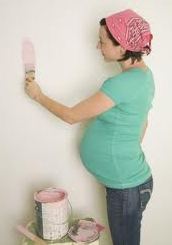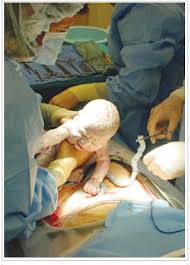March 13th, 2011 by Linda Burke-Galloway, M.D. in Better Health Network, Health Tips
No Comments »

 I came across an article the other day about paint and pregnancy. Yes, that paint — the kind that you put on a canvas or slap on your walls. Did you know that paint is made of pigment particles in a liquid base called a medium? Oil paints are thinned or cleaned with paint thinners. Latex paints are thinned or cleaned with water. Most paint that’s used in the home is latex.
I came across an article the other day about paint and pregnancy. Yes, that paint — the kind that you put on a canvas or slap on your walls. Did you know that paint is made of pigment particles in a liquid base called a medium? Oil paints are thinned or cleaned with paint thinners. Latex paints are thinned or cleaned with water. Most paint that’s used in the home is latex.
Can environmental forces affected pregnancy? The short answer is “yes,” according to the Organization of Teratology Information Specialists (OTIS), whose mission is to study malformations of the unborn.
Regarding paint and pregnancy, the amount of exposure is important. A one-time household exposure causes fewer problems than ongoing exposure through a work setting. And there have been medical studies documenting babies being born with problems if their mothers abused toluene-containing paint in order to “get high.” Toluene is a paint thinner that can cause low birth weight, premature labor, small head size, and developmental delays. Again, these problems only occur if pregnant women have been exposed to very high levels of toluene — much higher levels than exposure based on a hobby or a professional painter.
According to OTIS, working as a painter doesn’t pose concrete risks to the pregnancy. However, any reduction in chemical exposure is always a good thing. Read more »
*This blog post was originally published at Dr. Linda Burke-Galloway*
January 27th, 2011 by Linda Burke-Galloway, M.D. in Health Tips, Opinion
No Comments »

 The journey to a healthy pregnancy and delivery begins with the selection of a healthcare provider, and the challenge is to find the right one. This is the person who will be in charge of your pregnancy up until the time of the delivery, so it certainly is not a casual date. For the next 280 days your life and the life of your unborn child will be in this person’s hands. A background check is therefore in order.
The journey to a healthy pregnancy and delivery begins with the selection of a healthcare provider, and the challenge is to find the right one. This is the person who will be in charge of your pregnancy up until the time of the delivery, so it certainly is not a casual date. For the next 280 days your life and the life of your unborn child will be in this person’s hands. A background check is therefore in order.
One of the best ways to find the right healthcare provider is by word-of-mouth referral from neighbors, friends, or family members however please don’t stop there. Labor and delivery nurses are also a great source of referral because they have seen physicians and midwives under their most vulnerable and challenging moments.
Don’t feel intimidated about checking a provider’s credentials — this is public information. You can find out whether the provider’s medical license is current or expired. You’ll also be able to obtain information on whether the provider has ever been disciplined by the board for medical malpractice or unprofessional behavior or misconduct. Healthcare providers are not exempt from problems with alcoholism, drug addiction, professional incompetence, and unprofessional or unethical behaviors. Although less than five percent of healthcare providers have egregious problems, you want to make certain that your provider is not one of them. Read more »
*This blog post was originally published at Dr. Linda Burke-Galloway*
January 11th, 2011 by Linda Burke-Galloway, M.D. in Better Health Network, Health Tips
No Comments »

 Although I’ve been a proponent for the prevention of medical errors for years and wrote a book to address those issues, I think my obstetrician-gynecologist (OB/GYN) colleagues are finally catching on.
Although I’ve been a proponent for the prevention of medical errors for years and wrote a book to address those issues, I think my obstetrician-gynecologist (OB/GYN) colleagues are finally catching on.
Dr. Patrick Duff of the University of Florida’s OB/GYN department wrote an article in the December issue of the journal Obstetrics & Gynecology that caught my attention. In his article, “A Simple Checklist for Preventing Major Complications Associated with Cesarean Delivery,” Duff outlines steps that OB/GYNs should take in order to reduce complications during and after a cesarean section. Duff patterns his list after Dr. Atul Gawande’s book, “The Checklist Manifesto: How to Get it Right,” which has set the standard regarding reducing complications after surgery. According to Duff, the following steps should be taken in order to reduce complications after a cesarean section:
1. Clip hair at the surgical site just before making the incision to reduce wound infections. Duff states that there is a greater chance of promoting infections when the hair is shaved the night before the procedure. He also recommends clipping hair as opposed to shaving which reduces the rate of would infections.
2. Cleanse skin with chlorhexidine solution rather than iodine because medical studies have demonstrated a reduction in infections using chlorhexidine solution.
3. Give broad spectrum antibiotics before the surgical incision as opposed to after the newborn’s umbilical cord is clamped. Read more »
*This blog post was originally published at Dr. Linda Burke-Galloway*
 I came across an article the other day about paint and pregnancy. Yes, that paint — the kind that you put on a canvas or slap on your walls. Did you know that paint is made of pigment particles in a liquid base called a medium? Oil paints are thinned or cleaned with paint thinners. Latex paints are thinned or cleaned with water. Most paint that’s used in the home is latex.
I came across an article the other day about paint and pregnancy. Yes, that paint — the kind that you put on a canvas or slap on your walls. Did you know that paint is made of pigment particles in a liquid base called a medium? Oil paints are thinned or cleaned with paint thinners. Latex paints are thinned or cleaned with water. Most paint that’s used in the home is latex.












